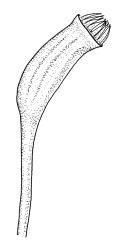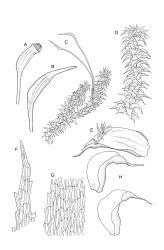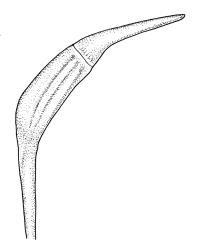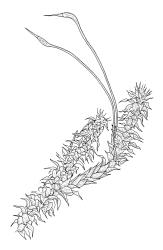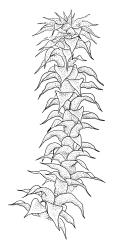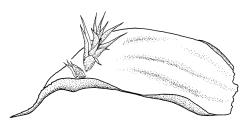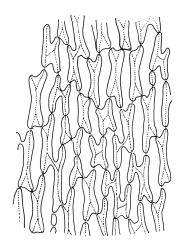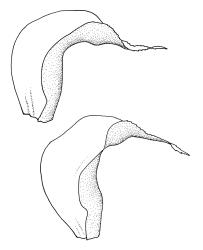- ≡ Hypnum densifolium Brid., Muscol. Recent. Suppl. 2, 204 (1812)
Plants yellow- to brown-green, lustrous, variable in size, forming wefts that are compact and neat in appearance. Secondary stems ascendant, usually c. 40–70(–100) mm, mostly branched by forking, stiff, red-brown, not visible between leaves either fresh or dry, in cross-section with many layers of thick-walled cortical cells and lacking a central strand. Leaves squarrose and strongly imbricate throughout, thin and chartaceous, only slightly more squarrose when dry, oblong below, scarcely narrowed to insertion, abruptly tapered to a rather short (c. 0.8–1.0 mm), toothed and twisted acumen, with several basal plicae extending from the base to ⅓ the leaf length, mostly c. 3.5–4.2 × 1.5–2.0 mm when well developed; mid laminal cells thick-walled and porose, mostly c. 45–57 µm, becoming longer towards insertion; cells at insertion shorter and pigmented in a band, those in alar angles forming a small, weakly defined group. Costae usually indistinct, double. Paraphyllia and gemmae absent.
Phyllodioicous. Perichaetia scattered on secondary stems, the inner leaves oblong-obovate, abruptly acuminate, sheathing, the outer leaves widely spreading. Male plants dwarf and epiphyllic on female plants. Setae as per genus, to at least 25 mm; capsules c. 3.5 mm, strongly curved; operculum with a very long and slender rostrum, ± equal the capsule; annulus and peristome details not seen in N.Z. material. Only immature spores seen in N.Z. material.
Tangney & Fife 1997, figs 1–2, 5–6; Kühnemann & Gonçalves Carralves 1975, Pl. I, fig. 1, Pls. X–XI; Seppelt 2004, fig. 94.
Ptychomnion densifolium is a very attractive species made distinctive by its formation of compact, neat, turf-like colonies and its strongly squarrose and imbricate leaves, which completely mask the stem in both fresh and dry material. Capsules are rare in N.Z. In the Ptychomniaceae, P. densifolium could be confused only with its congener, P. aciculare, but it is nearly always readily distinguished by the characters given in the key. Confusion is more likely to occur with the adventive Rhytidiadelphus squarrosus. Ptychomnion densifolium can be distinguished from R. squarrosus by its neater, less branched, and more compact habit, its porose laminal cells, its poorly differentiated alar cells, and its occurrence in undisturbed vegetation at higher elevations.
NI: Wellington (Ruahine Range, Tararua Range). SI: Nelson (numerous collections from Cobb Valley and Mt Peel vicinity, Matiri Range, Mt Priestly), Canterbury (Broad Stream, Worryline Stream), Westland (numerous localities), Southland (Gertrude Valley, Longwood Range), St, A, C. Recorded from many localities on M by Seppelt (2004).
Austral. Argentina*, Tristan d’Acunha*. Reported from Chile by Kühnemann & Gonçalves Carralves (1975).
Mainly occurring at insolated sites (e.g. grassy banks, ledges) in subalpine or alpine grassland or mixed grassland scrub, often with Chionochloa pallens and various species of Olearia and Dracophyllum present and often on humus over rock. Less often in dense subalpine scrub or light gaps in southern beech forest.
On the North I. known only from a few localities between 1140–1400 m elevation. On the South I. occurring from (800–)1000–1400 m elevations, with most occurrences below c. 1000 m associated with watercourses. On Stewart I. this species descends to sea level and is apparently tolerant of some salt spray. Associated bryophyte species often include Breutelia pendula, B. robusta, Pleurophascum ovalifolium, Pyrrhobryum mnioide subsp. contortum, Lepidolaena hodgsoniae, and Trichocolea spp. In the Gertrude Valley it is very common in Chionochloa pallens–Dracophyllum–Olearia grassland/scrub and occurs only between c. 950 and 1050 m. Both Vitt (1979) and Colin Meurk (pers. comm.) indicate that P. densifolium is usually associated with Bulbinella rossii (Chrysobactron) on Campbell I.
The earliest record of P. densifolium from N.Z. is that from Campbell I. by Vitt (1974).
Tangney & Fife (1997) discussed early N.Z. records and noted minor differences between the N.Z. populations and the Tristan d’Acunha type.
I know nothing of the Chilean P. densifolium var. gracile Cardot & Broth., but in N.Z. P. densifolium is quite variable in size. Most populations have shoots c. 4–5 mm wide, but robust plants with shoots c. 6–7 mm wide are frequently seen. There appears to be a tendency for more northern populations to be more robust. The robust populations appear to be representative of the species in other respects and are unworthy of taxonomic recognition.



